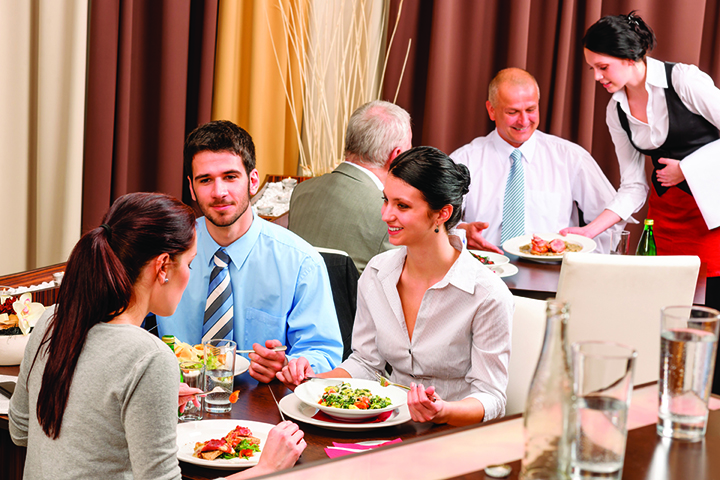In this first quarter of the year, we are typically hit with all sorts of data and commentary about the state of the industry. Whether it is a critic talking about the decline of fine dining in the restaurant sector, or the rise of corporate drop off in the catering sector, there is a lot for our potential clients to digest when faced with settling upon how to celebrate an important event.
Advantages, disadvantages…what might you think of first if you were in your client’s shoes and needed to feed and entertain 100 people? Maybe, “Well, I sure love that little restaurant up the block. Their filet mignon is delicious. I’ll give them a call.” Or, it could be, “That wedding I attended last month was so fun, delicious, entertaining. I wonder who did all that work?”
How do you stand out? What is your unique advantage as a restaurant? As a caterer?
From the vantage of a SWOT analysis (Strength, Weakness, Opportunity, Threat), let’s take a look at some various scenarios regarding how you can gain traction in 2017.

Different approaches to the same end
Whether catering events offsite or hosting patrons at your restaurant, the end goal is the same—to entertain. Our job as restaurateurs and as caterers is to create the perfect atmosphere, provide excellent professional service, and to offer our guests delicious culinary creations, beautifully presented. Where we do this is really inconsequential, but how we do it is very different.
The pros, the cons & everything in between
Strength–Restaurants: In a restaurant environment we are working with a full cooking line, offering chefs every tool imaginable to make that perfect dish, as well as a variety of vessels to enhance the appeal. As the menus become more complex (think molecular cuisine, etc.) the equipment does too, and a modern day restaurant kitchen can sometimes look more like a chemistry lab than a kitchen. This is a great position to be in, allowing your chefs high creativity and a place to try new techniques and tastes.
Weakness–Catering: In catering, it is rare that we are working somewhere as well equipped as a restaurant kitchen. Likely, most of the prep and some of the pre-cooking is done in advance with finishing and plating done onsite. This creates the challenge of offering dishes that can be as interesting as your clients are accustomed to having in a restaurant. Opportunity: Work to your “weakness.” You may not have molecular gastronomy at the ready, but your catering chef will blow a restaurant chef out of the water, when working an outdoor party, in the rain, with sketchy electricity, and only a six foot folding table for mise en place.
Opportunity–Catering: Most guests don’t even consider the challenges of catering for hundreds or thousands when booking an event. I am always amused when a catering client comes to us wanting the same dish they had in a particular restaurant—like we have an intimate knowledge of how that specific chef produces the dish!—and that we can do so for dozens or hundreds of people simultaneously.
Our response to this cannot be a simple “no.” We must educate and accommodate our clients. My usual response to a request like this is to question what in particular the client liked so much about the dish and then suggest ways we could do something similar but in a way that will work in a catering environment. More often than not this leads to a happy client and a realistic goal for the catering team.
Threat–Restaurants: While restaurants may have the advantage of a fully equipped kitchen, they do face a challenge regarding the sheer economics of the business. Think of it this way: in a typical restaurant you stock up your fridges, do hours of prep work, bring in all your staff, open your doors—and then pray that patrons decide to dine that night. If the local team has made the playoffs, if a snowstorm blows in—whatever might happen to make people change their minds and stay home—means a lot of wasted labor and probably some wasted food as well. Of course I am using an extreme example since reservations help us plan, but then let’s compare it for a minute to the catering business.
Strength–Catering: In catering, you know how many people are coming, exactly what they are eating (except maybe for that surprise ‘gluten free’ guest) and, if you are smart, you are paid in full before the event occurs.
Strength–Restaurants: An advantage to the restaurant business is the ability to offer choice. Restaurants can have varied menus with plenty of choices for any preference while in catering we are typically narrowing down the options to a single menu or perhaps a handful of choices.
Threat–Catering: One factor always in play is what I like to refer to as ‘Risk vs Reward.’ This considers the size of the group being served and the likelihood that if you are serving a single choice there will be disappointed guests. The larger the group, the more mainstream you may have to go to reduce the risk. Sometimes, however, taking a risk can generate great reward.
Opportunity–Catering: I remember one such occasion when we were contracted to cater a gala dinner for 700 guests. While beef tenderloin would have made the statement ‘elegant, high-end, gala-like,’ it wasn’t an option, as the group was a not-for-profit fashion association with a limited budget. But then I had an idea. With this fashionable crowd we would push the envelope and embrace a trend. Much like fashion itself it wouldn’t matter so much if our course selection was ‘expected’ but rather would it be memorable. As such, Indian restaurants were popping up all across the country at that time and Indian fine dining had become a catchphrase we were hearing more and more. Normally we avoid chicken for large events as it typically denotes ‘convention center’ menu, but I knew our team could pull off something interesting. The main course of the night would be Butter Chicken, served beautifully in an oversized wing bowl with crispy triangles of toasted Naan and finished with a dollop of raita. The dish was a huge hit, and the risk paid off.
Weakness–Both: Regardless of the differences, the pros and the cons of each, catering and restaurants still share the same goal of entertaining and feeding our guests. They also share the same economic challenges of managing costs. Whether you run a restaurant or a catering business you know very well the bottom line is what counts at the end of the month, and keeping an eye on your food costs, your labor costs, and your liquor costs (the big three I like to call them) will mean the difference between success and failure!
SWOT’s the real difference, then?
Various differences aside, there is one thing the restaurant and catering business will always share, and that is passionate people who work long hours with the goal of creating a special experience for our guests. We could have chosen a lot of careers and the one we settled on certainly isn’t the easiest, but we chose it for a reason. As long as we love what we do we should be committed to doing it as well as we can, pouring 100% of our hearts and souls into every meal we serve and every guest we serve it to!

Sebastien Centner is the Director of Eatertainment Special Events & Catering (www.eatertainment.com) and the Creative Director of JECKL agency (www.jeckl.us) which concepts and executes events around the globe.
Sebastien launched Eatertainment Special Events & Catering, which has grown to be one of Canada’s top event planning and catering companies and was awarded ‘Best Caterer in Canada’ by the Canadian Event Industry Association. Currently Eatertainment hosts over 900 events each year in Canada and the US.
Sebastien has spearheaded and seamlessly executed hundreds of events for high-profile clients including Red Bull, TIFF, Hugo Boss, BMW and Porsche. Sebastien has also had the privilege of hosting events for such public figures as Martha Stewart, President Bill Clinton and Brad Pitt, to name a few.
Sebastien contributes his savoir-faire to a number of charitable events and has, over the past few years, built a reputation as an industry trendsetter, becoming a go-to source for inspiring at-home entertaining concepts. Known for hosting the most stylish dinner parties, Sebastien not only has a keen eye for design and an amazing attention to detail but also never ceases to amaze his guests with creative menu selections, cool cocktails, chic décor and beautiful table settings.
Recognized as an ‘Entertaining Expert’ and media personality, Sebastien is a regular expert on The Marilyn Denis Show and his concepts, recipes and lavish events have been featured in Hello! Magazine, EnRoute, Style at Home, Toronto Fashion, The National Post, The Globe & Mail, Toronto Sun, House & Home, among others.
Sebastien is proud to be working in an industry that he is so passionate about. Aside from his family, his greatest satisfaction is felt when he is able to help a client produce an unforgettable event. Sebastien lives in Toronto with his wife Sheila and their two sons.
Follow Sebastien
twitter.com/sebcentner
Follow Eatertainment



